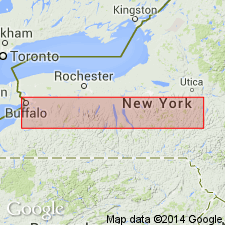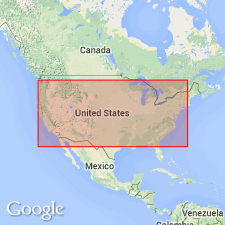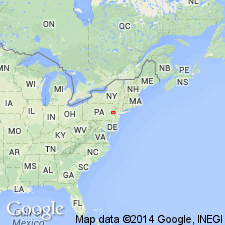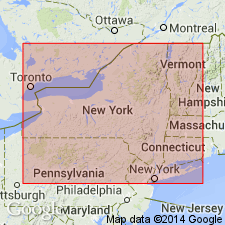
- Usage in publication:
-
- Union Springs member
- Modifications:
-
- Named
- Dominant lithology:
-
- Limestone
- Shale
- AAPG geologic province:
-
- Appalachian basin
Summary:
Union Springs member of Marcellus formation named in this report. Consists of alternating beds of black limestone and sooty shale overlying Onondaga limestone and underlying Cherry Valley limestone member of Marcellus from Unadilla Valley westward to Seneca Lake. Thickness is 17 ft at type section in Wood's quarry. At Marcellus it is 13 ft thick, at Oneida Creek above Stockbridge Falls, 25 ft, and on Flint Creek, near Phelps, 9 ft. It is not known west of Phelps, Ontario Co., NY.
Source: GNU records (USGS DDS-6; Reston GNULEX).

- Usage in publication:
-
- Union Springs member
- Modifications:
-
- Overview
- AAPG geologic province:
-
- Appalachian basin
Summary:
Bakoven shale represents easternmost known facies of Union Springs shale. In Cayuga Lake region, the Union Springs is black limestone, but in eastern central NY it is sooty-black shale. In Catskill region, the Union Springs is dark sandy shale with PARACARDIUM and BUCHIOLA. Basal member of Marcellus; underlies Cherry Valley limestone member; overlies Onondaga limestone. Age is Middle Devonian.
Source: GNU records (USGS DDS-6; Reston GNULEX).

- Usage in publication:
-
- Union Springs Shale Member*
- Modifications:
-
- Areal extent
- AAPG geologic province:
-
- Appalachian basin
Summary:
Union Springs Shale Member of Marcellus Shale extended into east-central Pennsylvania.
Source: GNU records (USGS DDS-6; Reston GNULEX).

- Usage in publication:
-
- Union Springs Formation
- Modifications:
-
- Revised
- AAPG geologic province:
-
- Appalachian basin
Summary:
Marcellus Formation will be "formally" raised to subgroup status within the Hamilton Group and be divided into a lower Union Springs Formation and an upper Mount Marion Formation (in eastern New York), and an upper Oatka Creek Formation (in central and western New York), in a publication by Ver Straeten and others (in prep). Union Springs Formation will incorporate three members across New York: the Bakoven Member (geographically extended across the State of New York), the Stony Hollow Member (restricted), and the Hurley Member (new). The Hurley underlies the Cherry Valley Member at the base of the laterally equivalent Mount Marion and Oatka Creek Formations. The Bakoven unconformably overlies the Seneca Member or, where absent, the Moorehouse Member of the Onondaga Formation.
["Subgroup" not recognized as a formal stratigraphic rank term (CSN, 1933; ACSN, 1961, 1970; NACSN, 1983, 2005, 2021). Considered informal and should not be capitalized.]
Source: Modified from GNU records (USGS DDS-6; Reston GNULEX).
For more information, please contact Nancy Stamm, Geologic Names Committee Secretary.
Asterisk (*) indicates published by U.S. Geological Survey authors.
"No current usage" (†) implies that a name has been abandoned or has fallen into disuse. Former usage and, if known, replacement name given in parentheses ( ).
Slash (/) indicates name conflicts with nomenclatural guidelines (CSN, 1933; ACSN, 1961, 1970; NACSN, 1983, 2005, 2021). May be explained within brackets ([ ]).

